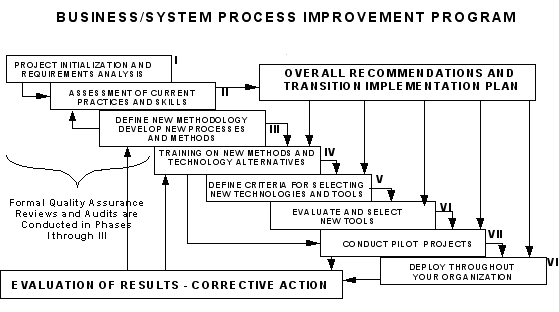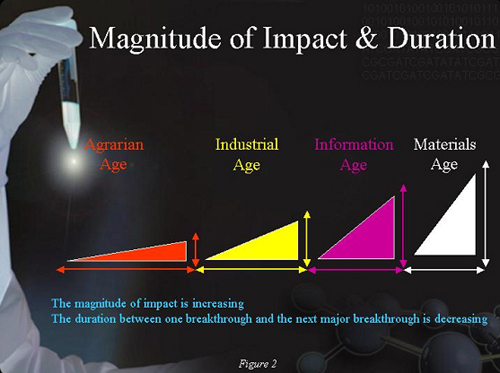In this issue NanoNews-Now Editor Rocky Rawstern and contributing writers David Sharon, Jack Uldrich, and Kevin Coleman cover Change Management, and guest columnist Pearl Chin discusses 20 points towards "Bringing Your Business Idea to Market."
"At the last turn of the century, the average person would have had a hard time trying to understand how cars and airplanes worked, and computers and nuclear bombs existed only in theory. By the next turn of the century, we may have submicroscopic, self-replicating robots; machine people; the end of disease; even immortality.
Hard to imagine? Not for the new breed of scientist who says that the 21st century could see all these science fiction dreams come true thanks to molecular nanotechnology, a hybrid of chemistry and engineering that would let us manufacture anything with atomic precision. In fact, scientists claim that even within the next 50 years, this new technology will change the world in ways we can barely begin to imagine today." From How Nanotechnology Will Change the World
"... an immense technical, business, and social tsunami is coming along shortly ... companies are already being forced to deal with a blinding rate of technological change. This speed-up will likely increase, and definitely spread." (our emphasis)
Gayle Pergamit and Chris Peterson Palo Alto, California, April 1997
Join us as we review Change Management.
Go directly to:
Return to Top
Transitioning to a New Technology is a Balancing Act
Here is a Road Map to Guide You Through the Change
"I am not an advocate for frequent changes in laws and constitutions. But laws and institutions must go hand in hand with the progress of the human mind. As that becomes more developed, more enlightened, as new discoveries are made, new truths discovered and manners and opinions change, with the change of circumstances, institutions must advance also to keep pace with the times. We might as well require a man to wear still the coat which fitted him when a boy, as civilized society to remain ever under the regimen of their barbarous ancestors."
The Words of Thomas Jefferson, The Jefferson Memorial, Washington, D.C.
Note: This is the first in a series of article addressing the challenges of managing technology transitions. The road map presented in this article is not specific to Nanotechnology. Specific challenges facing Nanotechnology will be elaborated on in subsequent articles.
My goal today is to present a guide for Project Managers responsible for transitioning new technology into a business enterprise. I always wished I could have found a concise checklist of what I was supposed to consider doing. Managing a technology transition is complex but I have learned what needs to done to successfully plan and conduct a technology transition project. I have gained my experience from 35+ years in the computer industry building both embedded and information systems.
Relating my experience is intended to be a "whack on the side of the head" to get you to think about the right issues, ask the right questions, and not make errors of omission. Critical success factors are stressed to ensure a successful technology transition. My goal is to help you save money, save time, and meet your process improvement objectives. I want to help you to formulate the appropriate transition/migration plan for your organization and apply the most appropriate methods and tools for achieving the desired results.
THE LESSONS LEARNED
Replacing technology is a process of managing change and requires a pragmatic approach to plan, manage, and conduct the transition project. Over the years I have learned:
- Workflows and processes need to be improved before improving the technology. Business processes and technology have become inseparable. Based on my experience, systems designed in conjunction with reengineered workflows and procedures are more successful than systems that cause an adaptation of workflows and procedures during the technology implementation.
- Introduction of new processes, methods, standards, and tools requires a transition migration plan. Managing change will continue become more complex as business processes and information technology become more integrated. Incremental development and implementation requires a comprehensive transition plan to ensure success of the project.
- Achievement of improvement objectives must be measurable. Management wants to know you are doing the right thing and doing it well. Metrics need to be defined which relate directly to the objectives of the system to prove you are building the right system. Process and methodology metrics are used to ensure you are building the system properly.
- All improvements begin with people. Plans, methods, and tools are meaningless without the people to apply them.
- All improvements occur because of people. People are the key enabler for implementing process improvements.
- There are no silver bullets.
|
Past Premium Newsletter Issues - click on the titles to read a short extract
July '03 - Batteries Excluded.
Aug '03 - Riding the Tiger. Preparing for nanotechnology.
Sept '03 - Nanomedicine.
Oct '03 - Small is Bountiful. Investing in nanotechnology.
Nov '03 - Nanotechnology and Warfare.
Dec '03 - Molecular Nanotechnology.
"For those searching for news and background information on trends and research in the field of nanotechnology, consider your search over!"
Discover.com
NanoNews-Now is an official
media sponsor for:

European Congress & Exhibition NanoTrends Munich, May 26 - 28, 2004.
|
NanoNews-Now Editorial Calendar
|
|
Feb '04
|
Education
|
|
Mar '04
|
Bulk Nanotech
|
|
Apr '04
|
Security
|
|
May '04
|
Nanotubes & Buckyballs
|
|
Jun '04
|
Thin Film
|
|
Jul '04
|
Memory & Chip Technology
|
|
Aug '04
|
Jobs
|
|
Sep '04
|
Life Extension
|
|
Oct '04
|
Space Elevator
|
|
Nov '04
|
Investments
|
|
Dec '04
|
Self Assembly
|
|
Jan '05
|
Patents
|
|
|
CRITICAL SUCCESS FACTORS
Nanotechnology will have significant impact on an organization's workflows, procedures, and job responsibilities. Many issues surround managing the development and deployment of Nanotechnology. These transitions could take years and need to be carefully planned and managed to avoid problems. Transition issues have organization and technology components. I have learned some valuable lessons including (1) managing the organization and technology issues involved in implementing a new technology and (2) planning the strategy for managing the transition.
I have learned many lessons managing technology transition projects. The factors contributing to the potential success or failure of a new technology have been of particular interest to me. Although each technology and organization has its own unique characteristics, I have identified five critical success factors. These factors are:
1. Understanding the impact of the new technology on the workflow, job procedures, job responsibilities, and business rules, and planning and dealing with the transition of the organization. Regardless of the size of the project, project teams become so involved with technology that they discount or overlook the impact on the organization. Upgrading the technology infrastructure of an information system always impacts the organization. Many transition projects are justified solely by the need to upgrade technology. Technology transitions that are justified based on new business needs have a better chance of success because by definition the current system is not adequately supporting the needed work flows, procedures, and policies of the business.
2. Developing comprehensive verification and validation plans, procedures, test cases, and test scenarios which relate directly to the new technology being developed but also to the new workflows the new system will initiate. The requirements of the new system are the basis for testing the technology. The requirements specify the conditions, the events, the states, and the rules of the system from which specific test conditions can be defined. Because the new technology will impact workflows and procedures, the test cases should be organized into work scenarios that represent the way work will be done. In this way, the users are not only verifying and validating the new system requirements but also learning how the technology operates. The sooner the users can begin this acceptance testing the better. Comparing the requirements and workflow diagrams for the new technology to the existing system helps optimize the new technology and prepare for the resulting transition.
3. Installing, implementing, and training all affected parties on a thorough transition management infrastructure (also referred to as the fundamentals of engineering management) which includes process and project management, requirements management, configuration and change management, document management, and system verification, validation, and acceptance testing. I will describe these fundamentals in subsequent articles and how to apply the fundamentals in the Transition Migration Plan.
4. Managing all the models (requirement definitions) relevant to the transition project (includes business process models, data models, system design models, architecture models, communication models, user interface models). I am shocked by how careless organizations are in recording, storing, and maintaining requirements. Requirements are the most valuable raw material in planning of a transition project. Models are far better than text in expressing requirements for user confirmation. Models provide the needed documentation for maintaining and enhancing the new technology. The key enabler for model management is the configuration and control system, a component of transition infrastructure.
5. Involving the entire organization in the change process invoked by the technology transition project. People are the key component of any transition project. Total organization involvement will help ensure the success of the project. When not involved, people become suspicious of the project's intent. They are protective of their jobs. If they can not see the benefits of the proposed changes, they are likely to fight the implementation or even sabotage it. Combating these negative reactions is easy by involving everyone from the beginning. People who participate in the current system assessment are able to identify system improvements and the new requirements. These same people become the ambassadors for the new system to the rest of organization.
I did not identify management commitment as a success factor. This is much over-used clich╚. What is appropriate commitment of management? It is the support in terms of operating plan approval and budget dollars allowing the five factors outlined above to become a reality. Management stating their commitment in staff meetings, company newsletters, memos, and public speeches is shallow, hollow, and meaningless if not backed up with dollars, resources, and approved plans. Meaningful commitment must be for multiple years, thus crossing the traditional boundaries of fiscal years.
A PROCESS IMPROVEMENT PROGRAM
New technologies are justified by their process improvements (both efficiency and effectiveness). Doing the right things and doing them well, and creating the desired outcome are the goals. The first step is to state the desired process improvement in terms of measurable objectives.
Managing a technology transition project requires a formal approach. At my firm, CASE Associates Inc., we use our own Business/System Process Improvement Program ę for planning and conducting the transition project. The phases of the program are:
Phase I. Project Initialization and Requirements Analysis: Establish Program Objectives and Expectations
Phase II. Current Assessment: Assess Current Practices and Skills
Milestone Review - Transition Planning Briefing
Plan for the controlled implementation of the new organization, processes, and methods. Validate the responsibilities and actions for the subsequent phases.
Phase III. New Methodology: Develop new organization, processes and methods
Phase IV. New Practice Training: Conduct training on new methods and technology alternatives
Phase V. New Technology Criteria: Define criteria for selecting new technologies and tools
Phase VI. New Tool Selection: Evaluate and select new technologies and tools
Phase VII. Pilot Project: Build a new system or reengineer an existing system using new practices and tools
Phase VIII. Deployment: Deploy new practices and tools throughout the organization
THE TRANSITION MIGRATION PLAN
There are five possible responses to change:
1. Ignore it
2. Deny it
3. React to it
4. Anticipate it
5. Create it
Circa Dave Sharon, 1997
The transition/migration plan deals with all aspects of changing and replacing an existing system. This change management perspective covers the entire system: the culture, the organization, the people, the business objectives, the business processes, the business policies and procedures, and the supporting information systems. The plan details why the transition is necessary (the justification), what needs to be done to accomplish the transition (the methodology), and how to conduct the transition (the strategy). A subsequent article will provide insight into helping you justify your transition project. An overview of the key methodological steps will be described followed by a generic strategy that I have found to be a good starting template for customizing a strategy to your unique situation. The strategy will be broken down into the technology transition stages and provides you the context for preparing a complete transition/migration plan.
Depending on the origin of the change, Business Process Reengineering (BPR) is the process for reacting, anticipating, and creating change. BPR, when combined with workflow analysis, provides the template for planning the transition/migration project and for managing change. BPR looks at the entire enterprise and provides the justification for the changes and process improvements identified by the new technology.
There are two types of systems: a manual system and a automated system. The manual system is comprised of people, procedures, policies, rules, data, and information that can be modeled as the business process. By automating the business system, technology components are added to the business process. A change to the manual system may require a change to the automated system, while a change to the automated system almost always impacts the manual system. It is common today to find inseparable links between the business processes and the supporting automated systems.
Why you reengineer is determined by business objectives. These objectives are validated during the BPR project. The prioritization and sequencing of business processes to be replaced is determined by these validated objectives. The process of reengineering is specified by the methodology. What to do is specified in a work breakdown structure of tasks, activities, and deliverables. What you use to reengineer are techniques and tools specified by the methodology.
This reengineering methodology can be applied up and down the business hierarchy, which is comprised of the organization's mission, objectives, strategies, tactics, operations, and technology. A change anywhere in the hierarchy can trigger changes elsewhere. A comprehensive reengineering methodology guides you in analyzing the impacts of change in an organization. A reengineering methodology deals with all elements of the hierarchy.
The Organization Hierarchy
MISSION
OBJECTIVES
STRATEGIES
TACTICS
BUSINESS OPERATIONS
TECHNOLOGY
Technology is the supporting foundation of the business enterprise. The requirements for the technology are derived from the business operations (the office-level business processes and related procedures). Business operations are defined based on the tactics used to implement specific company business strategies. These strategies are directly linked to the business objectives, which fulfill the company's mission statement. Business process reengineering takes all these components into account.
A ROAD MAP FOR CHANGE
A driving force in support of change is the need to maintain a company's competitiveness. New technology can change the way a company operates, makes decisions and serves its customers. Nanotechnology is a reality that will impact many aspects for our business and personal lives. A road map is needed for managing the transitions.
|
David Sharon is the CEO and Principal Consultant of CASE Associates Inc. Mr. Sharon began his career developing software. For the next twenty years he participated in technology changes that impacted the development of embedded and information systems. He experienced technology transition successes and failures. A technology consultant since 1987, Mr. Sharon has focused on business and system process improvement, change management, quality assurance, risk management, and technology evaluation, selection, and deployment. He developed the Business/Process Improvement Program© The program defines the steps for developing the plan, objectives, quality metrics, and process improvements for managing technology transitions.
He has been a contributing editor for IEEE Software Magazine and the Encyclopedia of Computer Science plus has published over 100 articles.
He can be contacted here.
|
Return to Top
|
NanoNews-Now Editor Rocky Rawstern asked Jack Uldrich, Author The Next Big Thing Is Really Small, and President of the NanoVeritas Group, to contribute to the theme. Here is what he had to say:
|
 |
Nanotechnology Demands an Open Mind
and "Exponential" Thinking
In 1913, Lee De Forest was prosecuted by U.S. government officials for claiming to potential investors that his company, RCA, would soon be able to transmit the human voice over the Atlantic Ocean. The prosecuting officials argued that his claim was so utterly ridiculous that he was surely ripping off investors. He was ultimately released but not before being admonished by the judge to stop making any more fraudulent claims. The rest, as the old saying goes, "is history."
I start my article on change management with this story because it serves as a poignant reminder that the relentless forces of technology can lead to predictions that sound nonsensical or unbelievable to people who do not understand where science and technology is headed. The story holds particular relevance to the broader business community because virtually every industry -- including the computer, semiconductor, energy, health care, insurance and manufacturing sectors -- will soon be confronted with seemingly nonsensical and unbelievable predictions that are about to be created by the new and emerging science of nanotechnology.
Many business people are familiar with Moore's Law, which states that the number of transistors that can be placed on a computer chip doubles every 18 months. This seemly simply law has increased the number of circuits on a chip from a mere 2,400 in 1973 to over 200 million today. Late last year, Intel announced the creation of a 90-nanometer circuit which will create transistors measuring on 50-nanometers in length and put more than 400 million transistors on a chip. The development will technically move the semiconductor sectors into the realm of nanotechnology. The development is however only the tip of the proverbial iceberg. The latest draft of the International Technology Roadmap for Semiconductors states that within ten years most semiconductors will likely be produced with nanotechnology techniques. If you understand exponential growth and nanotechnology it is reasonable to understand how many in the scientific community are predicting that computers will soon become 100 and then 10,000 and eventually one million times more powerful than those we have today.
A cursory review of nanotechnology developments in other fields may shed some useful light on the amount of change coming to other industries. Nantero, a Massachusetts-based company, is developing carbon nanotubes to produce "non-volatile" random access memory capable of storing a trillion bits of data per square centimeter -- nearly 1000 times more than today's best RAM. If successful - and they are reportedly partnering with some major semiconductor companies -- the entire $100 billion data storage industry will experience seismic change. Longer-term, Hewlett-Packard and others are working on atomic storage resolution, a development which would enable a device the size of a sugar cube to storage the entire contents of the Library of Congress (250 million books).
|
The industries that nanotechnology will likely have a disruptive effect on in the near term include the following:
(Amounts are Billions of US Dollars)
|
$1,700
|
Healthcare
|
|
$600
|
Long Term Care
|
|
$550
|
Electronics
|
|
$550
|
Telecom
|
|
$480
|
Packaging
|
|
$450
|
U.S. Chemical
|
|
$460
|
Plastics
|
|
$182
|
Apparel
|
|
$180
|
Pharmaceutical
|
|
$165
|
Tobacco
|
|
$100
|
Semiconductor
|
|
$92
|
Hospitality / Restaurant
|
|
$90
|
US Insurance
|
|
$83
|
Printing
|
|
$80
|
Corrosion Removal
|
|
$57
|
US Steel
|
|
$43
|
Newspaper
|
|
$42
|
Diet Supplement
|
|
$40
|
Diet
|
|
$32
|
Publishing
|
|
$30
|
Catalysts
|
|
$27
|
Glass
|
|
$24
|
Advertising
|
|
$18
|
Cosmetics
|
|
$13
|
Chocolate
|
|
$10
|
Battery
|
|
$5
|
Blue Jeans
|
|
$4
|
Khakis
|
|
$2.8
|
Fluorescent Tagging
|
|
|
|
Two promising nanotechnology start-ups, Nanosys and Konarka, are racing to develop polymer-based solar panels embedded with nanocrystals that are so efficient and flexible that they can be used in everything from clothing to roofing shingles. Their goal is produce supper-efficient solar cells that can be printed as easily and cheaply as rolls of wallpaper. If successful, the energy and utility industries will undergo a paradigm shift of historic proportions. Nanotechnology advances in the efficiency and effectiveness of solar cell and fuel cell technology portend the day when cheap, clean, sustainable energy can, quite literally, be generated at a person's home.
The prestigious British Medical journal, Lancet, citing the vast potential benefits of nanotechnology in drug delivery and disease diagnosis, recently called for papers in nanomedicine to be published in the spring of 2004. The call is not premature because some nanotech-based drugs are now in FDA Phase I clinical trials and the U.S. government's top expert in nanotechnology, Mike Roco, has publicly stated that nanotech will be the basis for 50 percent of all pharmaceutical products by the end of the decade. In fact, the National Health Institute publicly stated last year that by 2015 it believes that nanomedicine will play an integral role in curing a number of cancers. Other nanotechnology developments point toward the day when disease is no longer treated after it has occurred, but rather is prevented before it can occur. Alzheimer's, diabetes, and obesity are just a few of the diseases being targeted by nanotechnology.
These medical advances are obviously good for society but one side-effect is that health care and medical technology companies may see entire product lines -- and their corresponding revenue generating streams - evaporate literally overnight. Big change is coming to the health care sector and they need to begin preparing for it today.
The earlier diagnosis and treatment of disease will also put immense pressure on the insurance industry. For instance, as diagnostic technology gets more effective and less expensive, people's perception of risk - and thus their need for insurance - will be greatly altered. A second issue is that medical advances may radically alter life expectancy projections. What will happen to insurance industry profits if people suddenly begin living well in their 100's as a result of nanotechnology developments? The bottom-line is that the insurance industry is going to face severe pressure in the coming years and some of insurance companies may not survive.
Even mundane industries like the textile industry are being revolutionized by nanotechnology. Nano-Tex now has agreements with Eddie Bauer, Lee Jeans, GAP, and Old Navy to carry a number of products that contain their NANO-CARE technology -nanofibers which effectively repel coffee, wine and other ingredients from staining the material. The net effect of this simple technology may well be that the demand for the services of dry cleaners (as well as the demand for laundry detergent) may decrease dramatically. Other nanotechnology developments being investigated at the Institute of Soldiering Nanotechnologies at the Massachusetts Institute of Technology include creating uniforms which can camouflage themselves instantaneously depending on their unique environment - be it a desert in Iraq or an urban environment in Somali. If a uniform can change instantly, the question the textile and fashion industries must ask themselves is why not a shirt or a sweater? If such a development is possible, how do they begin preparing for that change today?
Even the food industry is experimenting with nanotechnology. For instance, Kraft Foods hopes to employ nanotechnology to create foods that can be individually altered with nanotechnology to accommodate the unique taste and health-care needs of individual customers. The bottom line is that the food sector can quite possibly, thanks to nanotechnology, become rivals to the pharmaceutical and health-care industries in the prevention and treatment of disease.
All of these developments - from computers a million times more powerful, to data storage devices capable of holding millions of books in a device the size of a sugar cube, to super-efficient solar cells, to cancer-curing drugs, to cloths and foods that change on demand -- may sound fantastic. But do they really sound any more fantastic than Lee De Forest claim in 1913 to be able to transmit the human voice over the Atlantic Ocean?
Change happens and, due to exponential advances that nanotechnology is enabling, change is only going to occur at an ever faster rate. The best way for each industry to begin preparing for this new reality is to understand the field of nanotechnology.
If they fail to do so their fate may be similar to that of the Swiss watch industry. In 1968, the Swiss controlled 80 percent of the world market for high quality watches. By 1973, their market share had plunged to less than 20 percent and the country witnessed the displacement of 50,000 watch-makers. The reason? A relatively simple technology, quartz technology, rendered state-of-the-art mechanical watches obsolete. Nanotechnology has the potential to do the same thing - and not just to one industry but virtually every industry.
The 20th century philosopher, Bertrand Russell, once said "Almost everything that distinguishes the modern world from earlier centuries is attributable to science." He was right then and, prophetically, he is even more correct today at the beginning of the 21st century. The future is going to look radically different than it does today and the science of nanotechnology is going to be one of the primary reasons.
Businesses which understand the science of nanotechnology, grasp the power of exponential growth, and keep an open mind to the possibilities which nanotechnology will enable cannot only survive the future they can prosper in it.
|
Jack Uldrich is the president of the NanoVeritas Group, a consultancy that focuses on helping businesses, venture capitalists, and governments understand, evaluate, prepare for, and profit from nanotechnology. Clients include leading venture capital firms, law firms, governments and Fortune 100 companies. Jack is the author (with Deb Newberry) of "The Next Big Thing Is Really Small: How Nanotechnology Will Change the Future of Your Business." Jack is a frequent speaker on the nanotechnology lecture circuit and has spoken before the Foresight Institute, The 2002 NanoBusiness Conference, The Piper Jaffery Investment Forum, 3M's "Big Thinkers" symposium, The World's Futurist Society and numerous trade associations and investment clubs. He is also a regular guest on the award-winning program, Almanac, and has appeared on CNN numerous times.
He can be contacted here.
|
Return to Top
|
NanoNews-Now Editor Rocky Rawstern asked Kevin G. Coleman, Ph.D., Senior Fellow with the Technolytics Institute to contribute to the theme. Here is what he had to say:
|

|
We live in a technologically intensive society where the rate of technological advancement is accelerating at a pace many find troubling. In the past thirty years we have experienced more dramatic changes brought about by technology than ever before in history. Given some in-depth insights into advanced technology, research organizations (both public and private) predict there are wondrous new developments ahead that will shape our lives. These scientific and technological breakthroughs have far-reaching political, economic and social implications. These implications are not limited in scope to the country or jurisdiction where the development takes place but throughout the world. In order to gain the proper perspective about the rate of technological advancement, one must examine the evolution of technology from the beginning. Technology began to evolve about 60,000 B.C. when primitive tools were first fashioned from sharpened stones and branches. As new scientific and technological advances entered into the marketplace, they ushered in a new age of social, economic and political growth.
The promise of nanotech has many concerned about the magnitude of change that will accompany the movement of this technology into the mainstream. Technolytics assessed the potential impact of NanoTechnology in business, government, society and education. Our impact horizon was divided into 4 time periods (current, short-term, near-term and long-terms. Figure 1 below presents our findings.
|
|
Current
|
Short-term
|
Near-term
|
Long-Term
|
|
Overall Impact
|
1.29
|
2.49
|
3.70
|
4.46
|
Figure 1 Scale: 1 = little or no impact 3 = Moderate impact 5 = Significant impact
As NanoTechnology evolves and matures the impact will increase until these techniques and materials become commonplace in over 200 industry segments. This evolution will require retraining of engineers, new curriculum, and changes to the mental modes that are ingrained in today's society. People and organizations have a finite amount of change they can withstand in a given period of time.
Figure 2 - below - illustrates the evolution of societal transformation brought about by technology. The materials age is brought about when BioTechnology and NanoTechnology combine and allow us to alter organic and living materials as well as create new exotic materials.
There are no technical solutions to the political and social problems that will be brought about by these new technologies. What is needed is a systemic change to our policy process and educational infrastructure as a precursor to further technological breakthroughs. Time is short - signs of mainstream applications of the technologies highlighted here have already begun to appear.
Opportunities will be created that will challenge power brokers in many industries and economic power distribution around the world. This technology merging and combining with BioTechnology will create cultural challenges and heated debate about the application of this technology in an effort to combat disease and personalize medicine. Those who are quick to adapt will undoubtedly become the winners in the next technology race. Those who lack the infrastructure (education and technology) and the ability to accept the social changes brought about by new technology will fall further and further behind.
Keep in mind:
|
"It should be considered that nothing is more difficult to handle, more doubtful of success, more dangerous to manage than to put one's self at the head of introducing new orders. For the introducer has all those who benefit from the old orders as enemies, and he has luke-warm defenders in all those who may benefit from the new orders." Machiavelli
|
The acceleration of technological progress has been the central feature of the last century and will continue in this century. I have presented in my research papers that we are on the edge of change comparable to nothing seen before other than the rise of human life on Earth itself. A change so profound it could dwarf the sum of all the different economic changes in history. A new technology revolution is coming. Will you lead - follow - or be pushed out of the way?
|
Kevin G. Coleman, Ph.D., is a Kellogg School of Management Executive Scholar and a Senior Fellow with the Technolytics Institute (an executive think-tank). An international management consultant, author and visionary, he brings significant insight into the global technology environment of tomorrow. Formerly he was the Chief Strategist at Netscape, prior to his role at Netscape he was VP & Chief Strategist at Claremont Technology Group, Business Week's 44 fastest growing company. He has personally briefed executives from 15 of the 50 largest companies in the world and nearly 450 CEOs worldwide. He is a strategic advisor to multiple companies and holds several board positions, including a two-year term on the board of the National Technology Transfer Center (NTTC), the organization responsible for commercialization of all government sponsored research. In addition, he has briefed both members of the House and the Senate on issues surrounding technology. For the past three years he has served on the Science & Technology Advisory Panel of Johns Hopkins University Applied Physics Lab, one of our nation's leading research institutions. He was recently appointed to the University of Pittsburgh Medical Center Limbach Entrepreneurial Center as a Strategic Advisor.
He can be contacted here
|
Return to Top

Pearl Chin - Managing General Partner, Seraphima Ventures
|
Bringing Your Business Idea to Market
|
Welcome to the first of a monthly column on investing, business and management issues in nanotechnology.
I decided to highlight 20 points that come immediately to mind time and time again when I am evaluating nanotech business plans for funding or consulting with startups on their business strategies. These points are applicable to all types of businesses as well. The most obvious points about bringing your ideas to market are presented here only because there will be some subtleties that have to be presented.
|
1. Have a business plan. And I don't mean just a written business plan. There are many books out there on how to write a business plan so that is not the difficult part. You should have a real, well thought out business strategy and model and be able to put the plan on paper with realistic assumptions and projections. Having a good business plan will mitigate the chance for failure. Someone else's business plan format might not be the appropriate template for you to illustrate your business model. Be clear on your goals and objectives.
You can use frameworks to help you structure your plan, such as the famous Porter Five Forces. If you do this, try to use a combination of frameworks to make sure you cover all your bases. Be realistic about your strengths and weaknesses and how you will address them. A lack of balance in your business plan will raise a red flag to potential investors. We're looking to see if you have a grip on reality.
You are not committed to this plan because what you don't anticipate in the market will sometimes force you to change your strategy later. However, a well thought out plan will also be able to anticipate some of those changes and will discuss how you will be prepared to address them when they come. You should have a good idea where you at least want to be and how to get there and be able to articulate it in written form. It is a living document.
2. What stage are you at in your business? Are you at concept stage (idea mainly), product development (pre-and post- prototype), or business development stage (manufacturing, marketing and sales)? It needs to be clear that you know where you are now so you can talk about where else you need to be.
3. Do you have intellectual property (IP) and does your IP need to be filed and protected? Important questions to ask yourself is will it be more expensive to patent it and protect it than to just stay ahead of the game with regard to your competition if they can easily duplicate your idea or reverse engineered your product? Coca Cola doesn't patent their secret formula. Patents expire. Seek legal advice for time, effort and costs here.
4. Are there any other legal or government regulations you must meet? If your product is a Bio-Nano product like a medical device or a drug, the FDA will have a say over whether it will be approved and can make or break you as it has for many a larger pharmaceutical firm. There are also health and safety codes for certain types of products. Do you know what procedures and fees are associated with these products?
5. In your market assessment section of your business plan, you will assess your target market and existing competition in terms of product and company. In my experience, this is the weakest section in most business plans because it requires the most work in terms of research. The problem is if your market assessment is weak, the overall marketing strategy will not work. You'll find all business aspects, like life, are interrelated although there are many who haven't figured this out yet. It is a similar concept as Supply Chain.
6. You will also need to be able to estimate your expenses and project revenues. For revenue projection, pricing your product appropriately does not necessarily mean just tacking on some margin to cover your costs. You should be able to demonstrate your product pricing logic and why your targeted customers will pay what you ask for.
7. If your product is a manufactured item, who, how, where, when, for how much, will you make it? You should be able to estimate this as part of your costs and expenses. Make sure you separate it into fixed and variable costs and can provide a breakdown of these items. The more detailed the better.
8. Be overly conservative on your revenue projections and overestimate your expenses. Point out on what bases you have curbed or overestimated your estimates.
9. With regard to your market assessment, who are your targeted customers? If you already have customers, that is a big plus. What do your customers want or what are their needs? Do you understand your customer? Is this a niche product in terms of commodity versus custom? Are you meeting their needs? It also helps if you are a potential customer.
10. Do you have more than one targeted market? One trick ponies don't have staying power once they've exhausted their only option. You'll need to know and discuss other markets you can move and expand into with your product or services.
11. Can your product evolve? The question here is if another similar product comes into the market, how will your company stay ahead of the competition and maintain or further gain market share? This is about being flexible and able to adapt to changes in the market, strengths and weaknesses of your product, and potential opportunities or competitive threats to your business. Typical SWOT (Strengths, Weaknesses, Opportunities, Threats) analysis here.
12. How will you market, sell and distribute your product? Will you do this yourself or ally with another company to take advantage of their distribution channels? How will this happen? These are some of the questions you should answer and potential investors, if you need them, will ask.
13. Who will be your CEO? The CEO entrepreneur has many functions in terms of the company and is critical and responsible for success. They are a combination of sales and marketing and fundraiser. The more things the CEO can do, the better he will be at leading the company. Are you resourceful? Are you an idea guy? People will want to follow a good CEO and not have to be forced to follow. A good CEO also knows what he is not good at and will bring in people to help them fill in those deficiencies. Keeping a tight reign on things as a CEO is good for quality control but not good if it's for ego issues. Are you someone who can see the big picture? These are typical leadership qualities written about in many leadership books and courses. There are natural born leaders but they also say leaders can be taught. If you are the inventor but are not the CEO type, be ready to pass the baton when needed. There are other positions you can take or even create that will still give you a say in the company if you cannot be CEO.
14. Getting back to management issues, who is going to manage the different aspects of your business? Unfortunately most investors are impressed by people who have good pedigrees and impressive backgrounds. However that is not the best way to pick your management team if you want to succeed although it may be a good way to raise money the way things are done these days. Many management people can hide their weaknesses and ineffectiveness in a large corporation. I've turned down business plans because of having interviewed management teams and found them to be inappropriate. In a startup environment, any deficiencies will be exposed early on because there is little room for error versus in a large corporation. A startup is often on the edge of do or die and there is no room for slack.
Try to assemble a team of people where each are capable of handling more than one area (e.g. operations, finance, marketing, sales, etc.). Good management people are able to do this. Does your management team play well together? How can you make this happen? Good people often have egos that need to be managed properly. You don't want too many prima donnas unless it's for a reason. Be diligent when you interview people for these positions.
15. Do you need help, such as business consulting, legal, sales, etc.? You're probably saying that you're a startup company and you can't afford to hire people. Well, be resourceful. Check out your nearest university for discount or free help from students. Many business school students can trade services for a project grade. Interns and students don't cost as much.
16. If you can't explain your business plan to the average person to the point where they can explain it easily to someone else, go back to the drawing board. You should be able to explain the concepts in plain language. Jargon will confuse and put off investors who are not as savvy. If the average person wants to invest in it, then you're on the right track.
17. Be able to adequately answer all questions. You need to be able to know your business inside out and anticipate all questions and have an answer for all potential questions. Otherwise, you haven't thought it through. Even if the answer is "I don't know" but you have thought about it and can present a proposal for remedying it which demonstrates that you are aware of your gaps and have a plan to fill them. Practice your pitch on everyone and get to the point where you can answer everybody's questions easily. You will be hearing some of the same questions over and over again. If the same question keeps coming up, it is an indication that you haven't addressed it appropriately in your pitch.
18. Put yourself or designate someone capable to play investors' advocate as a check for everything. If you can have several people as investors' advocate, even better. The more perspectives the better.
19. Fund it as far as you can by yourself and with private money you've raised before going for VC funding. We're talking friends and family and other angel investors. Research sources for grants and loans. Have you checked out the Small Business Administration backed banks for ideas for loans? Do you truly believe in your business idea that you are willing to risk your personal assets? Many startup companies max out their personal credit. I am not saying you should but this is common.
Of course, this could put you in a compromising position if things don't work out. 65% to 70% of new business will fail within the first five to eight years of operations. A good business plan will help you reduce this risk although it won't remove it. However, this is about risk and if you are risk adverse, you need to think about selling your idea in a different way. As an aside, it's easier to startup your company if you've got another source of income.
20. If you seek VC money, be prepared to give up much equity in exchange for their risk. This is another reason to try to find other ways to fund your business plan. Do not pursue venture capital money with the way venture capital industry is currently structured unless absolutely necessary and you have exhausted all other avenues. When you do go, do not wait until you have no leverage.
There are many VC firms out there. Not all VC firms are created equal. A good venture capital firm can help you in many other ways besides financing. They may be able to help with lining up customers or with your marketing strategy. Like any other relationship or marriage, make sure everyone is on the same page and has the same objectives. Just because a VC firm wants to invest in you doesn't mean it validates your business model and it's smooth sailing from then on. Don't live in a fantasy world. So do your homework. Actions speak louder than words. Otherwise, divorce later is much more painful than giving up the money now. Shop around. It also doesn't help if you look too desperate for money. That old saying that banks only lend to people who don't need the money is pretty accurate.
|
There are most certainly more points but these are the most frequent ones that come to mind. Even as simple as they sound, you might find that you'll need assistance making it happen. You can not do it along and there are so many other things that you have to make sure you do for your business to succeed however you choose to obtain this help. If it was so easy, every business startup given these tenets will succeed. The simplest concepts in life are often the most difficult to implement.
While making sure you can answer all these questions and/or address these points, remember your goal and objective of your business, which is to make money doing something you believe in.
Stay tuned for next month's article on venture capital and nanotechnology.
|
Dr. Pearl Chin, Managing General Partner, Seraphima Ventures. MBA from Cornell, Commencement Marshall, PhD in Materials Science and Engineering from University of Delaware, Center for Composite Materials, B.E. Chemical Engineering, Cooper Union.
She specializes in advising on nanotechnology investment opportunities. She consults for and writes a regular column for www.nanotech-now.com on business and management issues in nanotechnology companies. Dr. Chin is advising the student run VC fund at Cornell"s Johnson Graduate School of Management, Big Red Venture Fund, on investing in nanotechnology. Dr. Chin is also Managing Director of Glocap Search LLC Small Tech Practice.
She is a Senior Associate of The Foresight Institute in the US and was formerly US Representative of the Institute of Nanotechnology in the UK.
She can be contacted here.
|
Return to Top
In closing, these quotes:
In 1989, Bethlehem Steel was voted one of the best-managed companies in the United States. Twelve years later it went bankrupt, and in 2002, in an event as ironic as it was symbolic, the Smithsonian Institution bought the Bethlehem steel plant to convert it into the National Museum of Industrial History. The story serves as a poignant reminder that the relentless forces of technology and competition threaten even the most formidable of businesses. Steeling ourselves for innovation
"In the nearer term, many businesses will see the impact of nanotechnology. Among the industries not explored here and likely to be impacted in the not-too-distant future include:
* battery-scale energy storage - nanostructured fuel cells
* textiles - novel fibers and fabrics
* defense and security - surveillance, explosive detection and communications
* medical research - scaled down gene and protein array-based diagnostics
As with previous disruptive core technologies, such as gasoline engines, integrated circuits, and cellular radio, two key questions will remain.
Which companies will adopt and grow with this new field?
and
Which will be out-competed by new players?
Far from being a dream, nanotechnology will materially impact many of our economies largest markets during the next 10 years, and will be a common thread in many of the emerging businesses during this time. While medicine will lag other industries due to the multi-year average time for new medical technologies to emerge from clinical trials, it may be the most profoundly impacted within the next two decades."
Dr. Andrew Mutz, Managing Director Codesta. From: Nanotechnology Part Two: Markets
"Nanotechnology, the ability to inexpensively arrange atoms in most of the patterns permitted by physical law - often called the manufacturing technology of the 21st century - is expected to revolutionize essentially all manufactured products, from computers to medical instruments to solar cells to batteries to planes and rockets. " Ralph C. Merkle
From Our Molecular Future, by Douglas Mulhall:
-
What happens to the monetary system when everyone is able to satisfy his own basic material needs at very low cost?
-
How would we use cash when digital manufacturing makes it impossible to differentiate a counterfeit bill or coin from the real thing?
-
What happens to fiscal policy when digital information, moving at light speed, is the major commodity?
-
How fast will monetary cycles move compared to, say, the ten- or twenty-year cycles of the late twentieth century, when products and patents go out of date in a matter of months instead of years?
-
What happens when we don't have to worry about trade or social services for our basic needs, because most of what we need is provided locally with digital manufacturing, and the biggest trade is in information?
-
How do we control the excesses of the ultrarich, the overabundance of the molecular assembler economy, and the challenge to intellectual property laws created by intelligent, inventive machines?
-
What happens if half of all jobs are made redundant every decade?
-
What happens to the War on Drugs when there's no import, export, or transport of contraband because drugs can be manufactured in a desktop machine using pirated software downloaded from the Internet?
-
What happens to democratic controls when individuals can get as rich as small governments in a year or so?
-
What's the relevance of insurance if many things are replaceable at very low capital cost, but liabilities from software are potentially unlimited?
-
How should organized labor react when molecular assemblers and intelligent robots eliminate most manufacturing jobs?
-
What is the nature of work going to be?
-
What happens to land prices when an individual can build a tropical farm under a bubble in North Dakota, and get there from New York in an hour?
-
What happens when everyone can go everywhere, whenever they want, and work from wherever they want?
Return to Top
For further research, here are pages we found valuable:
Nano Markets Report: Summary about the state of Nanotechnology Industry Worldwide 2003-2015 (November 2003) Helmut Kaiser
The Social and Economic Challenges of Nanotechnology Stephen J. Wood, Alison Geldart, Institute of Work Psychology, University of Sheffield; Richard A.L. Jones, Dept of Physics and Astronomy, University of Sheffield
Five Ingredients for Financing Nanotech Ventures Nanotechnology Resources, Issue 1. Neil Gordon, Partner - Nanotechnology, Sygertech Consulting Group, Inc
Tips for Bringing Nanotech Products to Market Nanotechnology Resources, Issue 2. Neil Gordon, Partner ˝ Nanotechnology, Sygertech Consulting Group, Inc
Return to Top
IN THE NEXT ISSUE
Issue #8 will cover Education and Nanotechnology. It will land in your mailbox February 2nd, 2004.
Infamous Quotes:
"There is no reason anyone would want a computer in their home." (Ken Olsen, Digital Equipment Corp, 1977)
"Computers in the future may weigh no more than 1.5 tons." (Popular Mechanics, 1949)
"I think there is a world market for maybe five computers." (IBM's Thomas Watson, 1943)
"This 'telephone' has too many shortcomings to be seriously considered as a means of communication. The device is inherently of no value to us." (Western Union internal memo, 1876)
And the lesson is? It's a tough game to call.
Need advice? Check out NanoStrategies
© Copyright 1999-2004 7thWave, Inc. All rights reserved. More information on copyright, and disclaimers regarding the content of this newsletter can be found here |











